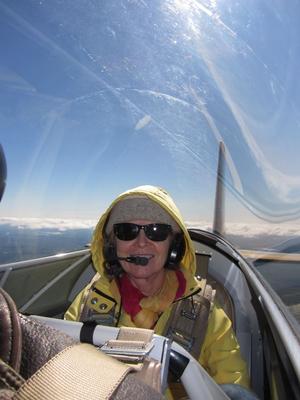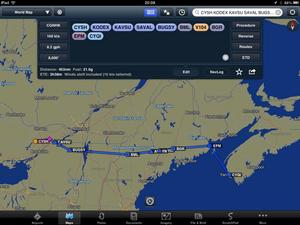Manitowoc Trip
- Details
- Written by Kevin Horton
- Hits: 3158
We got back late this afternoon from a great trip to Manitowoc, WI to visit some of Terry’s sisters. We flew down Saturday morning - airborne at 8:40, stopped at Sault Ste. Marie, MI for Customs and fuel, and arrived in Manitowoc at 12:13 (1:13 PM Ottawa time). We had hoped to stay until tomorrow, but all the weather forecasters predicted thunderstorms for that area on Tuesday, so we bailed out this morning. 3:34 flying time on the way there, and 3:39 on the way home. What a great way to travel!

Yarmouth Trip
- Details
- Written by Kevin Horton
- Hits: 3427

Terry and I flew to Yarmouth, NS on Saturday to visit my folks. I had filed a fairly simple route on the IFR flight plan, but ATC was having nothing of that. Ottawa Terminal gave me a long clearance which included four five-letter fixes that I had never heard of before. I was very happy to be using ForeFlight on my iPad, as it knew where these fixes were, rather than my having to search for them on an IFR chart to try to find where these guys were sending us.
Oxygen System Test
- Details
- Written by Kevin Horton
- Hits: 3262
I bought a Contec CMS50D pulse oximeter on eBay, based on a review published recently in Aviation Consumer. It arrived yesterday. Today, a planned all-day meeting finished at lunch time, and the weather was good, so I took some banked time off in the afternoon. I installed the Aerox oxygen tank in the forward baggage bay, ran the O2 lines into the cockpit, and went flying.
I measured the blood oxygen satuation at 9,500 ft, with the oxygen OFF, and found that it was about 94% of my sea level baseline reading. I donned the cannula, adjusted the O2 regulator, waited a couple of minutes then measured the oxygen saturation again. I found that it had increased to 99% of the sea level baseline. I climbed to 12,500 ft, and found the blood oxygen saturation was 98% of the sea level value with the oxygen ON and 86% of the sea level value with the oxygen OFF.
Conclusion: The oxygen system is working as expected. It should prove usful on some cross country flights, either where there are strong tailwinds available above 10,000 ft, or climbing above 10,000 ft will avoid icing conditions at lower altitude.
Bumpy Flight
- Details
- Written by Kevin Horton
- Hits: 3195
We had hoped to fly to Wisconsin on Saturday, to spend several days visiting some of Terry’s sisters. But, the weather took a distinct turn for the worse late in the week, and Saturday had extensive low cloud and cool temperatures. We would have had to fly IFR at 6,000 ft or higher, and the air temperature at this altitude would have been below freezing, which is a good recipe for ice. We’ll try again in a few weeks when everyone’s schedules align again.
I zipped out to the airport late Sunday morning to do a test fit of the latest iteration on the oxygen tank mount in the forward baggage bay. This version looks like a winner, but I need to order some different hardware to secure the tank clamps to the mount. I’ve also got a pulse oximeter coming, so I can monitor the oxygen saturation in my blood stream. That will allow me to confirm that the oxygen system is working properly.
I also should manufacture a shroud to protect the oxygen tank valve and regulator from the baggage that will also go in the baggage bay.
Sunday afternoon I did a short local flight. The winds were really blowing, as a cold front had gone through early in the morning. The winds were gusting to 25 to 30 kt (some of the airports in the area reported gusts to 40 kt, but I don’t think they got this high in Smiths Falls), but there were aligned within about 20 degrees of the runway, so the crosswind component was 10 kt, or less. It sure was turbulent though. The bumps extended up to 7500 ft, and it was so bumpy at low altitude that I had to slow to about 120 kt to keep from getting beat up too badly.
Landings in high winds are good workout, which is why I went flying. Two of the four landings I did went very well. The other two were marred by big wind gusts that hit around the time I touched down, which threw made things not nearly as tidy. But they were all safe.
Cruise Perf Update
- Details
- Written by Kevin Horton
- Hits: 2962
Back in January, I reported an apparent increase in performance since I reinstalled the engine. I had noted that the aircraft appeared to be several knots faster for the same power setting than it had been when flying over the last several years. My data recording system wasn’t working properly, but I hand recorded some data and plotted power vs speed (after correcting to standard conditions). This appeared to show about a 5 kt increase in performance.
A week ago I finally debugged the data recording system, so I recorded data on the laptop for a few conditions. This data showed results a bit slower than the hand recorded data from January. The latest results were 1–2 kt faster than what I had recorded over several flights in 2010, but that was quite different than the 5 kt increase I had seen in January.
I took a closer look at the data analysis from January, and I found a glaring, rookie error - I had failed to convert my hand recorded Outside Air Temperature numbers from deg F to deg C. Duh! I redid the analysis and now it shows results 2–3 kt faster than the 2010 data. Neither the hand recorded data from January nor the laptop recorded data from a week ago are perfectly clean, so this small difference between the two results is not surprising. Now that I know my data system is working again I’ll gather a bunch more cruise performance data.
Friday in Toronto
- Details
- Written by Kevin Horton
- Hits: 3244
We are having absolutely fabulous weather in southern Ontario this week. An upper high pressure system is parked over Ottawa, and it isn’t moving. Normally, the low and high pressure systems that affect our weather only exist in the lower atmosphere. The wind spins around these systems at low altitude, but once you get above 10,000 ft or so the winds are generally from the west. The westerly winds at medium altitude push the various weather systems from west to east across North America. If you want to get a rough idea of which way the low altitude weather systems are moving, you can normally look at the wind direction at 18,000 ft.
Sometimes you’ll see weather systems that stretch up into the upper atmosphere - hurricanes are a good example of that. But, there are many less powerful low and high pressure systems that extend way up too. Today we have an upper high pressure system over Ottawa, and an upper low pressure system over northern Alabama. These systems disrupt the normal weather patterns because the air at mid altitudes spins around in circles around these systems instead of it’s normal orderly flow from west to east. These systems generally move very, very slowly, and they block the systems to the west from moving further east. These upper systems will persist for an indefinite period, and then suddenly break up and the normal weather patterns will resume. The weather forecasters have a very difficult time predicting when these upper systems will collapse, so the long range weather forecasts are even less reliable than normal if there are upper high or low pressure systems in play. It could be here for another week, or it could be gone tomorrow. So, we’ll enjoy the good weather while it lasts.
Terry went to Toronto on Wednesday afternoon to attend a convention which would finish on Saturday afternoon. Friday afternoon I flew the RV–8 to the airport on Toronto Island (Billy Bishop Toronto City Centre Airport), to have dinner with Terry and stay the night. We had a great meal on Friday night. Saturday afternoon, after the convention wrapped up, I flew her home. Great flights in both directions - 1:02 on the way to Toronto and 1:04 on the way home. Sure beats the five hour drive, or the hassles of airline travel. The airport is on a small island right next to downtown Toronto, and is a perfect way to visit downtown Toronto. The CN Tower is just NE of the airport, so you get a great view of it while arriving and departing.
 I had reserved a tie-down spot at the Porter FBO. The staff at Porter were very friendly, helpful and efficient.
I had reserved a tie-down spot at the Porter FBO. The staff at Porter were very friendly, helpful and efficient.
